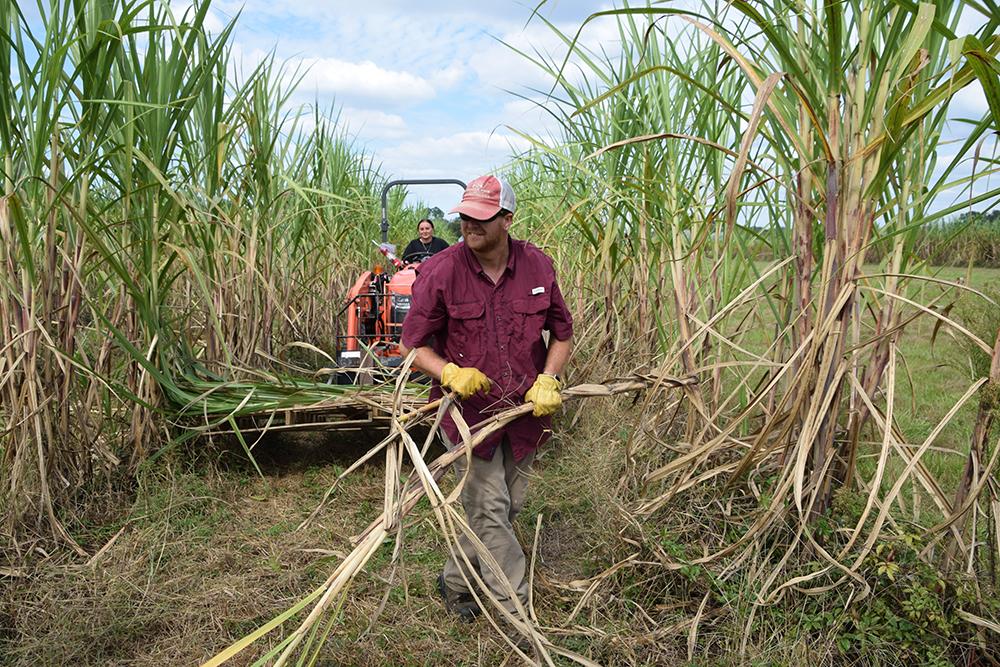MSU research station harvests tradition, opportunity for sugarcane in Mississippi

Contact: Meg Henderson
STARKVILLE, Miss.—Each fall, Research Associate Scott Langlois and his crew harvest a small sugarcane crop growing at the Mississippi Agricultural and Forestry Experiment Station’s South Mississippi Branch, honoring a 40-year-old agreement with the U.S. Department of Agriculture to sell seed cane to new or current growers, and it always sells out.
The Poplarville station’s history of sugarcane production and research dates to 1925. The ’20s and ’30s were times of robust sugarcane trial research for the station, when 87% of the state’s population were farmers. In 1938, the USDA established the Sugar Crops Field Station in Meridian as the Mississippi hub for sugarcane research, and its staff worked cooperatively with MAFES scientists on research until its doors closed in 1983.
Retired station Superintendent Ned Edwards explained that when the Meridian facility closed, the university agreed to plant three of its high-performing varieties of syrup cane and an heirloom chewing variety, initially at the MAFES Beaumont station in Perry County.
“When I came to Poplarville in 1989, it was being grown and distributed to farmers,” he said. “I’m glad someone at USDA had the foresight to ask MSU to take care of the seeds so they would not be lost.”
Edwards said the crop’s biggest limitation is cold temperatures. Northern Mississippi represents the northernmost edge of sugarcane’s growing range in the U.S. The only states that produce commercial quantities of sugarcane are Florida and Louisiana, where cultivation is most prominent in areas south of Interstate 10.

“Sugarcane can also be weakened by drought, which affects the height and quality of the plant,” said Langlois, who came to Poplarville in 2004. “Diseases and pests are not common, but a hurricane or even a strong storm can blow down the cane stalks. It won’t kill them, but they’ll grow curved, which makes them very hard to harvest.”
Edwards, who maintains a 20-year-old sugarcane field on his property, and Langlois have seen a surprisingly renewed interest in syrup making, especially from younger generations. Backyard sugarcane cultivation and syrup making have been long-running traditions since the crop’s introduction to the U.S. in the late 18th century. Today, small groups of enthusiasts want to preserve the agricultural science and art of their ancestors.
“We have young people coming to buy sugarcane, and they’re asking us for advice,” Langlois said. “Some of them remember helping their grandfathers or great-grandfathers make syrup, and they don’t want this family tradition to be lost. They also enjoy the community—when families come together for the harvest and pressing.”
Other customers seek new ways of using these traditional crops. In 2018, a hobbyist rum maker from Gulfport bought some cane from the station, pressed it and made a small batch of rum. Today, Circle Hook Distillery’s Agricole-style rum—developed in the French Caribbean islands from freshly squeezed sugarcane juice—has a devoted following and earned numerous awards in spirits competitions.
For inquiries about purchasing seed cane, call the research station at 601-795-4525. To learn more about the Mississippi Agricultural and Forestry Experiment Station and the South Mississippi branch, visit www.mafes.msstate.edu.
Mississippi State University is taking care of what matters. Learn more at www.msstate.edu.